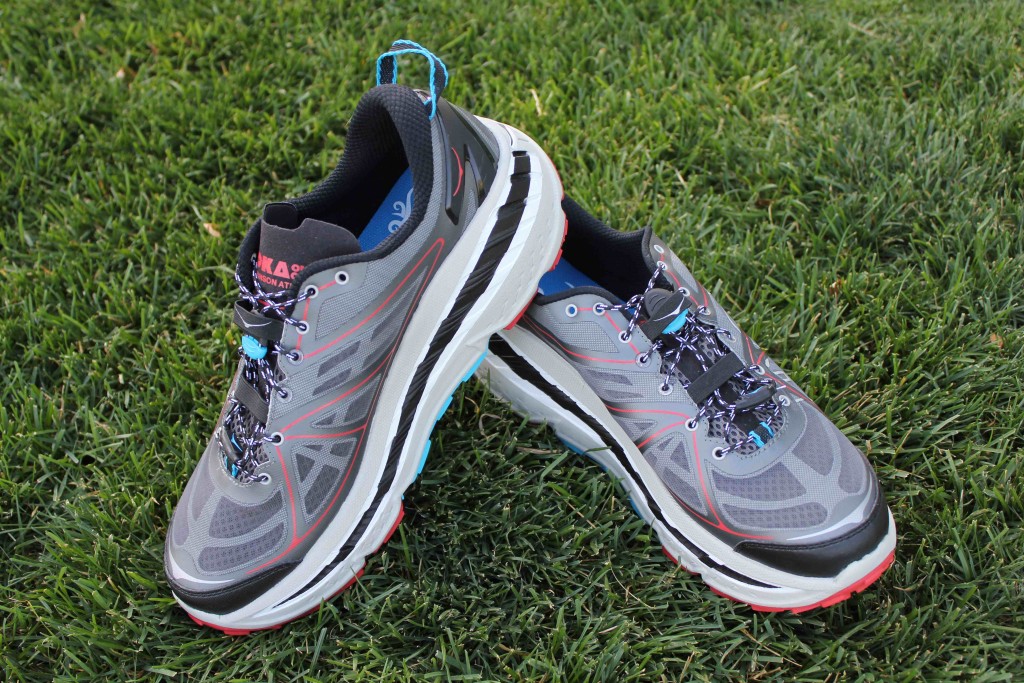The Hoka Stinson ATR is a unique trail running shoe that fits squarely in the “maximalist” category of trail shoes. This model is designed to emphasize one thing: cushioning! With 32mm of cushioning underneath the heel, these shoes look like nothing you have ever seen before. With such incredible shock-absorptive powers, Hoka shoes have gained an incredible cult following in the trail running community, especially amongst North American ultra-runners. Many a story has been told around the finish line of an ultra race of the broken down runner whose trail career and joy for running has been revived by wearing Hoka shoes. But with such an atypical design comes serious drawbacks as well. The shoes are large, heavy, emphasize heel-striking, and with such a massive stack height, are prone to stability issues and ankle rolling.
The Stinson ATR is an updated version of the old Stinson Evo and is essentially the same shoe but with a couple of noticeable upgrades. The ATR is a bit lighter and features a mono-mesh upper that is more breathable and sheds water easier. The tongue is lighter and is now joined to the liner in a “seamless” construction.Hoka Stinson ATR Review
Our Verdict
Our Analysis and Test Results
Hands-On Review
The Hoka Stinson ATR is a shoe designed specifically for ultra-length outings on the trails. The number one emphasis with its design is the amount of cushioning under your feet, with the idea of absorbing the repetitive impact of landing while running. It offers the best underfoot protection of any shoe we reviewed. Unlike the Salomon XA Pro 3D, which provides protection with a rockplate, this model protects solely with EVA foam. Hoka shoes are unique in their fit and feeling, and it seems people are either all-in or all-out with their love or hate of how these shoes run. Regardless, if you are planning to run an ultra or are looking for answers to overuse problems, they are undoubtably worth a try.
Performance Comparison
Foot Protection
We gave this model a perfect 10 out of 10 for protection, and how could we not with 32mm of underfoot cushioning in the midsole. Unlike most other protective shoes, there is no rockplate here, just EVA foam. The rockered sole shape provides a nice toe bumper and the reinforced laminate upper is designed to not articulate like other shoes, thereby eliminating a wear point.
Traction
Stability
With our foot having so much foam between it and the ground, we found that this was the least stable shoe in our review. The design obviously lends itself to this problem, and Hoka has countered by adding a “deep foot frame,” as well as a “meta-rockered geometry.” The deep foot frame design means that the midsole is designed specifically for the foot to sink deeper into the middle of the shoe upon landing. The meta-rockered geometry means that both the toe and heel of the shoe curve upwards, lending the runner a more rolling gait. While both of these technologies are noticeable in their effects, and do just as Hoka advertises, we still find this to be the least stable shoe we tried. For a well-cushioned shoe that is a little more “normal” feeling, you may also try the Asics Gel-FujiTrabuco 4 Neutral or the New Balance Leadville 1210v2.
Comfort
With the extreme cushioning and spongy landing surface, it was hard not to call these the most comfortable shoes in the review. Our complaints with older model Hokas (that they didn't drain well, didn't breathe well, and had a strange fit) have all been addressed with this newest Stinson model. The race-lace system cinched the upper around our foot and held it perfectly in place, and they seemed to run perfectly true to size.
Weight
Weight is not the strong suit of this product, but given how much shoe you are getting, it's actually remarkable they weigh as little as they do. Replacing the leather upper with mono-mesh has made the ATR a hair lighter than previous versions.
Sensitivity
With an unprecedented amount of protection also comes an unprecedented lack of sensitivity. We felt that there was little to no trail feel at all. Without getting much true feedback on the trail from our feet, we were forced to pay extra attention to where and how we landed.
Best Applications
Ultra-running is without a doubt the best application for the Hoka Stinson ATR. The less technical terrain the better, as highly technical terrain tends to emphasize the ATR's inherent design flaws (mainly its lack of stability). Many runners swear by the Hoka brand, claiming it is the only kind of shoe they can run long distances in without pain.
Value
With a price tag of $160, the Hoka Stinson ATR is by far the most expensive shoe that we have reviewed. If you are preparing to run 100 miles, or are looking for an answer to chronic injury or pain, then the price tag may well be worth it. For most applications though, we believe there are far higher performing trail running shoes available for much less money.
Conclusion
Hoka has designed a style of shoe that completely shifts the paradigm of what a running shoe can, or should, be. By emphasizing one particular design trait to the maximum (cushioning) and being willing to accept the limitations that come with it, Hoka has created an entirely new genre of shoes and a cult following to go with it. The Stinson ATR is the most well-refined Hoka trail running product that we have yet worn, and Hoka lovers will not be disappointed in the new upgrades.










